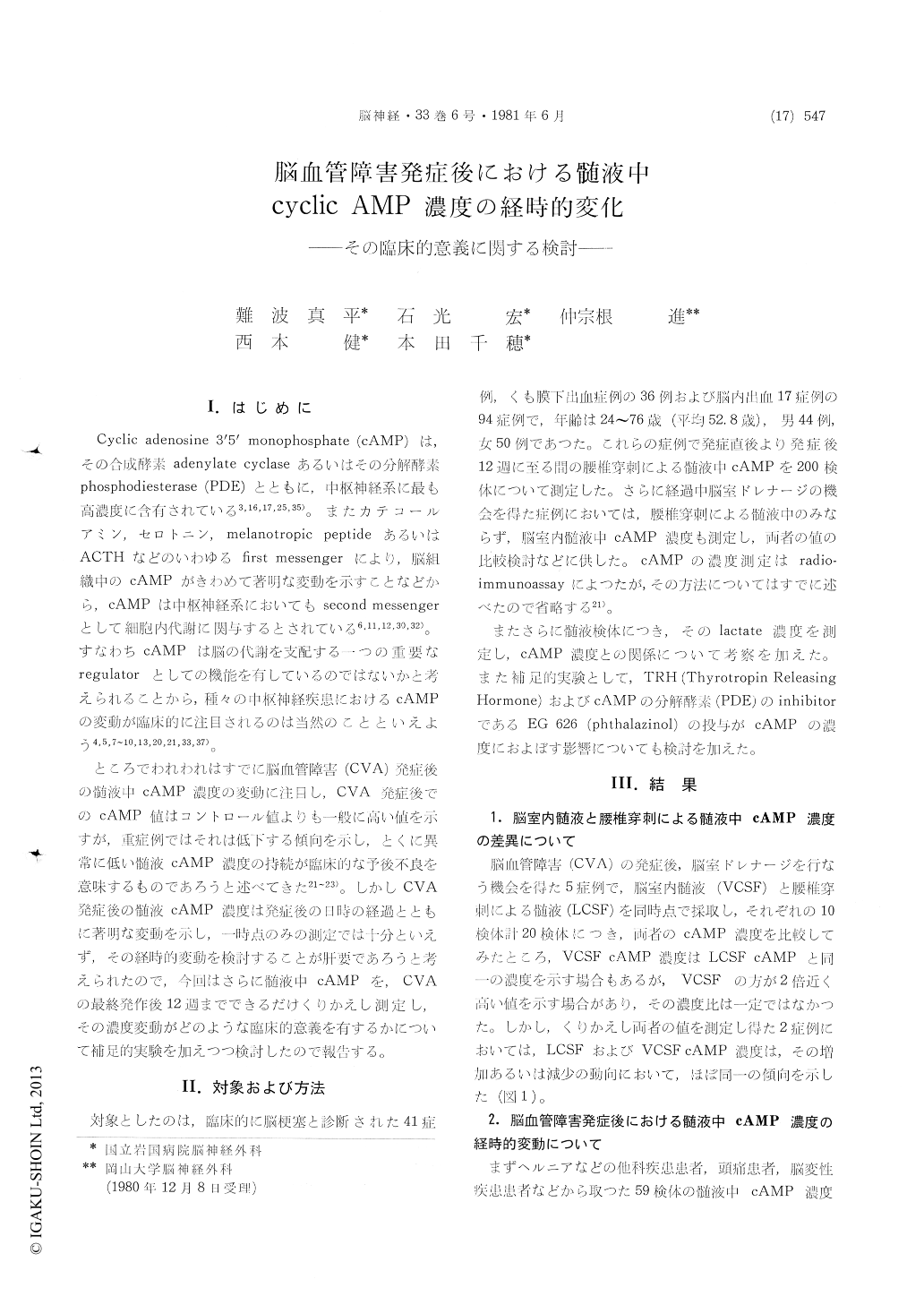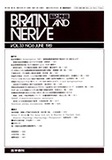Japanese
English
- 有料閲覧
- Abstract 文献概要
- 1ページ目 Look Inside
I.はじめに
Cyclic adenosine 3'5'monophosphate (cAMP)は,その合成酵素adenylate cyclaseあるいはその分解酵素phosphodiesterase (PDE)とともに,中枢神経系に最も高濃度に含有されている3,16,17,25,35)。またカテコールアミン,セロトニン,melanotropic peptjdeあるいはACTHなどのいわゆるfirst messengerにより,脳組織中のcAMPがきわめて著明な変動を示すことなどから,cAMPは中枢神経系においてもsecond messengerとして細胞内代謝に関与するとされている6,11,12,30,32)。すなわちcAMPは脳の代謝を支配する一つの重要なregulatorとしての機能を有しているのではないかと考えられることから,種々の中枢神経疾患におけるcAMPの変動が臨床的に注目されるのは当然のことといえよう4,5,7〜10,13,20,21,33,37)。
ところでわれわれはすでに脳血管障害(CVA)発症後の髄液中cAMP濃度の変動に注目し,CVA発症後でのcAMP値はコントロール値よりも一般に高い値を示すが,重症例ではそれは低下する傾向を示し,とくに異常に低い髄液cAMP濃度の持続が臨床的な予後不良を意味するものであろうと述べてきた21〜23)。しかしCVA発症後の髄液cAMP濃度は発症後の日時の経過とともに著明な変動を示し,一時点のみの測定では十分といえず,その経時的変動を検討することが肝要であろうと考えられたので,今回はさらに髄液中cAMPを,CVAの最終発作後12週までできるだけくりかえし測定し,その濃度変動がどのような臨床的意義を有するかについて補足的実験を加えつつ検討したので報告する。
The sequential changes of CSF cAMP concentra-tions after cerebrovascular accidents (CVA) were investigated. CAMP concentrations of the lumbar CSF and, in some cases of the ventricular fluid as well, were measured in 94 cases of CVA (41 cases of cerebral infarctions, 36 cases of SAH and 17 cases of intracerebral hematomas) at the various intervals until 12 weeks after the last attack.
1) CAMP concentrations of the lumbar CSF taken within 16 hours after the last attack of SAH were not significantly increased. The highest con-centrations were detected between one and twoweeks after the last attack, followed by gradual decrease to return to the control value in a month.
2) Lower than 5pmol/ml of cAMP concentrations had been detected from the onset to the death in the patients with extremely deteriorated sensorium. In the other patients who had been followed up to 12 weeks after the attack, the CSF cAMP con-centrations decreased before the death with or without preceeding elevation of the concentration.
3) Elevated lactate concentrations in CSF were found concomitantly in the cases with lower cAMP concentrations (less than 15pmol/ml).
4) Intraventricular cAMP concentration was lower in the case with disturbed consciousness than that of 2 patients with normal sensorium at the stage later than three weeks after the attack.
5) CSF cAMP concentration was significantly increased in the patients with improving conscious-ness 1-3 weeks after dialy TRH (Thyrotropin Releasing Hormone) administration, but the con-centration was not increased in the patients who failed to show improvement of the sensorium with the treatment.
6) CAMP concentration was increased after ad-ministration of the PDE (Phosphodiesterase) inhi-bitor, but clinical effect of the PDE inhibitor on disturbed consciousness was unclear so far.
Nevertheless CSF cAMP concentration was generally increased with a peak at around one week after the attack, it was demonstrated that lower con-centrations of cAMP were related with disordered sensorium after CVA. High lactate concentration in case with low CSF cAMP value might suggest disordered metabolism in consciousness disturbance. And it might be speculated that less than 5pmol/ ml of CSF cAMP concentration might suggest highly and irreversibly destroyed metabolism in the CNS, because no patients in this series with such a low value recovered. As the conclusion it might be mentioned that the correlation of CSF cAMP level with consciousness disturbance should indicate as a prognosticating feature of the CVA.

Copyright © 1981, Igaku-Shoin Ltd. All rights reserved.


